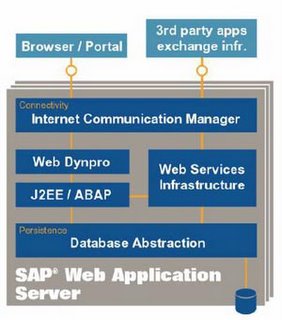Sunday, February 19, 2006
Download and Installation of Sneak Preview Version of SAP Netweavewer Package
To download this Trial Version, you can go to: https://www.sdn.sap.com/irj/sdn/downloads.
Just follow the installation guide in the installtion package.
Here I give you the list of items that you are going to install with the installton package.
1) SAP Web Application Server
2) SAP Enterprice Portal
3) SAP Content Mangement and Collaboration (not included TREX)
4) SAP Netweaver Developer Studio
5) SAP NetWeaver Development Infrastructure
6) SAP Composite Application Framework including Guided Procedures
7) Interactive Forms based on Adobe Software
Based on my own experience, although it is only required 1Gb RAM to run the portal, but I suggest you to have 2GB RAM in your system to install this. As you will see some undesirable result and waiting time to get some things load and execute by have just 1 GB RAM.
(especially when you have about J2EE engine, database, 3-5 portal browser with heavy memory execution, and your Netweaver Studio up running).
Good luck for the trial!
Sunday, February 12, 2006
Introduction to Portal Content
There are a few things that construct the portal content:
1) iView (we refer to this primarily)
2) Portal Page
3) Workset
4) Role
for delivery:
5) Business Package
An iView is basically an integrated platform for the web application to present contents.
A Portal Page can contain multiple iView the layout them in different positions. Worksets contain a set of portal pages and iViews that perform particular functional task, i.e. Executive Reporting function for executive group. While yo can assign a group of worksets to a role, then assign the role to an user so that he/she can see the contents of the worksets in the portal.
For delivery or content migartion, we can package all the objects (iViews, pages, worksets, and roles) in a unit call sda (software development archieve) as a Business Package.
(The print screen below will give you some idea on the explanation above.)

I will cover more on content administration in the future.
Sunday, February 05, 2006
SAP Web Application Server - the server that run the portal

As I mentioned in the previous blog, the Portal Runtime(PRT) is sitting beneath the J2EE Engine, while the J2EE Engine is part of the SAP Web Application Server.
Now, let's have a close look on the SAP Web Application Server( refer as WAS) architeture. Note that this is the latest Netweaver WAS Service Pack 15 architeture. (The WAS architeture has some major change from SP2 onwards, since SAP start using the Netweaver framework.)
You may wonder why the "Browser/Portal" box sitting outside the J2EE, since I mentioned that the PRT is located beneath the J2EE Engine. The "Browser/Portal" box is actually the front-end client browser.
As you may notice, the WAS can also connect to other 3rd party web applications or using web services through the SAP Exchange Infrastruture.
All the communications are managed by a component called "Internet Communication Manager",basically it conatains a dispatcher/servlet to forward the request and response.
So, what is the Web Dynpro component? As I mentioned in my previous blog, Web Dynpro technology is the latest technolohy invented by SAP to provide a fast bulding UI framework for business applications. Web Dynpro using a declarative concept (metadata modelling approach) where the programming tasks have been minimized to 20% , and almost 80% of the tasks can be done by modelling the metadata (with tables and diagarms - Web Dynpro toools).
In the persistance layer, here will be all the database abstracts including all the backend systems like database, SAP Systems and etc that provides the storage of persistant data.
In the future, I will future explain the pros and cons of the Web Dynpro technology, compare the the custom Java iViews/portal components development(J2EE) technology.
Wednesday, February 01, 2006
About Portal Runtime Technology (PRT)
(Yo provide a better defination on PRT, I quoted the following paragraph from help.sap.com - the link is provided on the left hand navigation column)
The Portal Runtime Technology (PRT) is a basic part of the SAP Enterprise Portal Environment that is integrated in the J2EE Engine environment.
The PRT provides a Java based framework that allows you to define, build, and execute applications in a portal environment by allowing the aggregation and the display of various contents such as rich text, XML, videos and so on.
The PRT provides a runtime and its corresponding services as well as a development environment for portal applications.
The design and the technical implementation of the PRT are based on the following points:
· The objective of the PRT is well identified and restricts itself to the life cycle of portal applications
· Open and extensible:
You can change or customize many of the components of the PRT and adapt them to the environment in which the PRT is executed. You can also extend the PRT to support, for example, different user interface models or different programming models.
The PRT clearly positions itself as one of the key blocks used to build and execute any kind of portal.
The PRT defines and enables you to manage two kinds of objects that define a portal application:
· Portal Components
A component that can be displayed in a portal page. From an application development perspective, a pluggable component designed to be executed in a portal environment
· Portal Services
A component that offers a globally accessible function in the portal. The PRT development model gives you a way of implementing a clear separation between a service API and its implementation.
